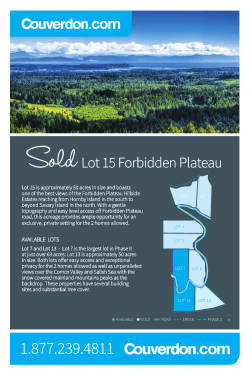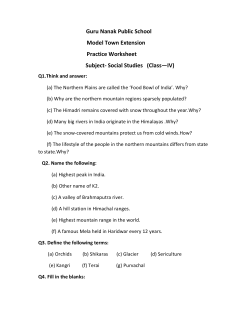
9 Geography 2 PHYSICAL FEATURES OF INDIA
(www.tiwariacademy.com) (Class IX) Question 1: Choose the right answer from the four alternatives given below. (i) A landmass bounded by sea on three sides is referred to as (a) Coast (b) Peninsula (c) Island (d) None of the above Answer: (b) Peninsula (ii) Mountain ranges in the eastern part of India forming its boundary with Myanmar are collectively called as (a) Himachal (c) Uttarakhand Answer: (b) Purvachal (b) Purvachal (d) None of the above (iii) The western coastal strip, south of Goa is referred to as (a) Coromandel (b) Kannad (c) Konkan (d) Northern Circar Answer: (b) Kannad (iv) The highest peak in the Eastern Ghats is (a) Anai Mudi (b) Mahendragiri (c) Kanchenjungaa (d) Khasi Answer: (a) Anai Mudi Question 2: Answer the following questions briefly: (i) What are tectonic plates? (ii) Which continents of today were parts of the Gondwana land? (iii) What is bhabar? (iv) Name the three major divisions of the Himalayas from north to south. (v) Which plateau lies between the Aravali and the Vindhyan ranges? (vi) Name the island group of India having coral origin. 1 www.tiwariacademy.com A Free web support in education (www.tiwariacademy.com) (Class IX) Answer 2: (i) Due to internal heat of the earth, the currents of the semi-molten rocks begin to move towards the crust and tear it apart dividing it into large fragments called lithospheric or tectonic plates. There are seven such major plates namely, South America, North America, Pacific, Indo–Australian, Eurasian, African and Antarctic. (ii) Gondwana land is the name given to the hypothetical ‘super-continent’ located in Southern hemisphere. Gondwana Land included South America, part of Africa (south Africa including Madagascar), part of Asia (India, Arabia, Malaya), Australia and Antarctica, prior to its breakup under the forces causing continental-drift. (iii) The ‘Bhabar’ is that narrow belt of the plain which is covered with pebbles and lies along the foothills of the Shiwaliks from the Indus to the Teesta. This belt is laid down by numerous streams descending down the hills. (iv) The three major divisions of the Himalayas from north to south are: a) The northernmost range which is known as the great Himalayas or Inner Himalayas or the Himadri. b) The range lying to the south of the Himadri which is known as Himachal or the lesser Himalaya. c) The outermost range of the Himalayas which is known as the Shiwaliks. These are the foothill ranges and represent the southernmost division of the Himalayas. (v) Malwa plateau or Central Highland (vi) Lakshdweep. Question 3: Distinguish between (i) Converging and diverging tectonic plates. (ii) Bhangar and Khadar (iii) Western Ghats and Eastern Ghats. Answer 3: (i) The internal heat of the earth makes the molten rocks to rush towards the surface of the earth and drive the crust into large fragments known as “Tectonic Plates”. These plates are drifting oven the mantle of the earth. As a result when the two or more plates are pushed towards each other they are called ‘Converging Plates’. On the other hand if they are moving away from each other, they are called ‘Diverging Plates’. 2 www.tiwariacademy.com A Free web support in education (www.tiwariacademy.com) (Class IX) (ii) According to the age of the soils of the Northern Plain they have been differentiated by two names: (a) Bhangar and (b) Khadar. The difference between these two are mentioned below: a) Bhangar - These are the older alluvium or old soil and form the largest part of the Northern Plains. They lie above the flood plains of the rivers and present a terrace like structure. It often contains Kankar nodules made of calcareous deposits. b) Khadar - The newer and younger deposits of the flood plains are known as ‘Khadar’. So, these are the new alluvium or new soil and are very fertile. Thus, Khadar is ideal for intensive agriculture. (iii) Western Ghats Eastern Ghats 1. The Western Ghats are situated and mark the western edges of Deccan Plateau parallel to the western coasts of India along the Arabian Sea. 1. The Eastern Ghats are situated and mark the eastern edges of Deccan Plateau parallel to the eastern coasts of India along the Bay of Bengal. 2. Continuous, can be crossed through the 2. Discontinuous, irregular and dissected by passes only. rivers draining into the Bay of Bengal. 3. The Western Ghats are higher than the 3. Average elevation is 600 meters. Eastern Ghats. Average elevation is 900 4. The highest peaks include the 1600 meters. Mahendragiri, the Javadi Hills. 4. The height increases progressively from 5. The Eastern Ghats also enclose a strip of north to south. The highest peaks include the land between its eastern slopes and the Bay Anai Mudi, the Doda Belta. of Bengal which is known as the Eastern 5. The Western Ghats enclose a narrow strip Coastal Plain. It is wider than the Western between its western slopes and the Arabian Coastal strip with its maximum breadth 120 Sea which is known as Western Coastal km. Plain. Its maximum width is 64 km. 6. It receives rain both in summer and 6. It experiences orographic rain mostly in winter, especially in winter through winter summer due to the summer monsoons. The monsoons. However, here the rain is lesser climate is hot and moist. than the western strip. 7. Here the soil is highly fertile. Rice, spices, 7. The soil is not as fertile as western strip. rubber and fruits like coconuts, cashew nuts Rice, ground nuts, cotton, tobacco, coconuts etc. are grown here. etc. are grown here. 3 www.tiwariacademy.com A Free web support in education (www.tiwariacademy.com) (Class IX) Question 4: Describe how the Himalayas were formed. Answer 4: The Indian Peninsula drifted towards the north and finally collided with the much larger Eurasian Plate. As a result of this collision, the sedimentary rocks which were accumulated in the geosynclines (known as Tethys) got folded and formed the mountain systems of the West Asia and Himalaya. Question 5: Which are the major physiographic divisions of India? Contrast the relief of the Himalayan region with that of the Peninsular plateau. Answer 5: The major physiographic divisions of India are the following: a) The Himalayan Mountain Wall of the north. b) The Northern Plains. c) The Peninsular Plateau. d) The Indian Dessert. e) The Coastal Plains. f) The Islands. The following table compares and contrasts between the relief of the Himalayan region with that of the Peninsular plateau. 4 www.tiwariacademy.com A Free web support in education (www.tiwariacademy.com) (Class IX) Himalayan Region Peninsular Plateau 1. The Himalayas are young fold mountains of comparatively recent origin. 1. They are a part of the oldest structures of the Indian subcontinent. 2. They are the highest mountains in the world. 2. The Central Highlands are formed of low hills and there is no high peak of world-wide fame in these hills. 3. Many great rivers like - the Indus, the Ganges and the Brahmaputra originate from the Himalayas. 4. The Himalayas are formed of the sedimentary rocks. 5. They are formed at the edge of the Indo-Gangetic Plain. 6. Important hill stations like - Shimla, Mussoorie, Darjeeling, Nainital are found on the Himalayas. 3. Very few rivers like - the Narmada and the Tapti originate from these hills. 4. The Central Highlands are formed of igneous and metamorphic rocks. 5. They are formed at the edge of the Deccan Plateau. 6. No well known hill station is found here. Question 6: Give an account of the Northern Plains of India. Answer 6: The Great Northern Plain extends from the Punjab Plain in the west to the Brahmaputra valley in the east. The Northern Plain has been formed by the interplay of the three major river systems namely - the Indus, the Ganga and the Brahmaputra along with their tributaries. The deposition of alluvium in a vast basin lying at the foothills to the south of the Himalayas over millions of years formed this fertile plain. It spreads over an area of 7 lakh square km. The plain is about 2400 km long and 240 - 320 km broad. The rich soil cover combined with the abundant water supply and favourable climate made this agriculturally a very productive part of India. Because of this factor the density of population is also the highest in this region among all the physiographic divisions of India. The Northern Plain is broadly divided into three sections: a) The Punjab Plain - It is the western part of the Northern Plain formed by the Indus and its tributaries. This section is dominated by the Doabs. b) The Ganga Plain - It is the largest part of the Northern Plain and extends between Ghaggar and Teesta rivers. c) The Brahmaputra Plain - It forms the eastern part of the Northern Plain by the river Brahmaputra and its tributaries. It is narrower than the Ganga Plain and is a flood prone area. In the south-east side of the Northern Plain lays the Ganga-Brahmaputra delta which is the largest delta of the world. 5 www.tiwariacademy.com A Free web support in education (www.tiwariacademy.com) (Class IX) Question 7: Write short notes on the following. (i) The Indian Desert (ii) The Central Highlands Answer 7: (i) The Indian Desert - It is an important physiographic division of India. Some of its features are as follows: a) b) c) d) e) f) g) h) i) It covers almost the whole of Rajasthan state. It lies towards the western margins of the Aravali Hills. Its vast expanse is covered with sand dunes which their shape day in and day out. This region receives very little rainfall which is below 150 mm so; there are very few streams in this area. It has arid climate with very little vegetation. During the rainy season small streams are sometimes seen for a short-while which disappears again in sand after the rains are over. Luni is the only large river in this area. Crescent shape dunes which are called Barchans are a prominent feature of the Indian desert. Camel is the most important animal of this desert. (ii) The Central Highlands - The northern division of the Peninsular Plateau lying to the north of the Narmada River covering a major area of the Malwa Plateau is known as the Central Highlands. The Vindhayas and its eastern extensions divide the Central Highlands from the Deccan Plateau in the southern side. In its west lies the rocky desert of Rajasthan, in the northwest it is bounded by the Aravalis, in the north lays the Gangetic Plain and in the east it is surrounded by part of UP and south Bihar. Most part of the Central Highlands consists of the Malwa Plateau and the Chhotanagpur Plateau. The eastward extensions are known as theBundelkhand and Baghelkhand. 6 www.tiwariacademy.com A Free web support in education
© Copyright 2025










